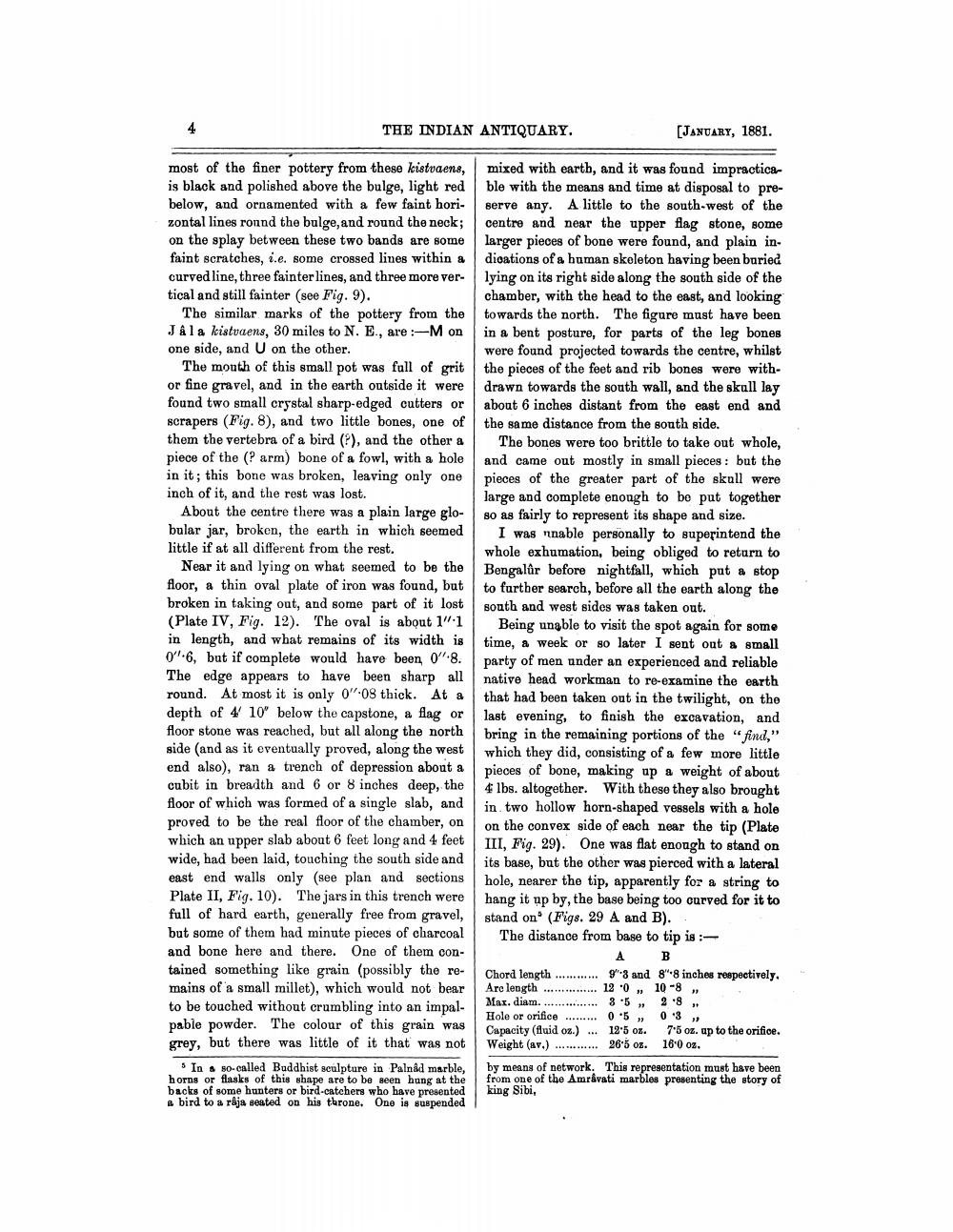________________
THE INDIAN ANTIQUARY.
(JANUARY, 1881.
most of the finer pottery from these kistvaene, mixed with earth, and it was found impracticais black and polished above the bulge, light red ble with the means and time at disposal to prebelow, and ornamented with a few faint hori- serve any. A little to the south-west of the zontal lines ronnd the bulge, and round the neck; centre and near the upper flag stone, some on the splay between these two bands are some larger pieces of bone were found, and plain in. faint scratches, i.e. some crossed lines within a dioations of a human skeleton having been buried curved line, three fainterlines, and three more ver- lying on its right side along the south side of the tical and still fainter (see Fig. 9).
chamber, with the head to the east, and looking The similar marks of the pottery from the towards the north. The figure must have been J Ala kistvaens, 30 miles to N. E., are :-M on in a bent posture, for parts of the leg bones one side, and U on the other.
were found projected towards the centre, whilst The mouth of this small pot was full of grit the pieces of the feet and rib bones were withor fine gravel, and in the earth outside it were drawn towards the south wall, and the skull lay found two small crystal sharp-edged cutters or about 6 inches distant from the east end and scrapers (Fig. 8), and two little bones, one of the same distance from the south side. them the vertebra of a bird (?), and the other a
| The bones were too brittle to take out whole, piece of the (? arm) bone of a fowl, with a hole and came out mostly in small pieces: but the in it; this bone was broken, leaving only one pieces of the greater part of the skull were inch of it, and the rest was lost.
large and complete enough to be put together About the centre there was a plain large glo
so as fairly to represent its shape and size. bular jar, broken, the earth in which seemed I was nnable personally to superintend the little if at all different from the rest.
whole exhumation, being obliged to return to Near it and lying on what seemed to be the Bengalûr before nightfall, which put a stop floor, a thin oval plate of iron was found, but to further search, before all the earth along the broken in taking out, and some part of it lost south and west sides was taken out. (Plate IV, Fig. 12). The oval is about 1".1
Being unable to visit the spot again for some in length, and what remains of its width is time, a week or so later I sent out a small 0:6, but if complete would have been 0.8.
party of men under an experienced and reliable The edge appears to have been sharp all native head workman to re-examine the earth round. At most it is only 0.08 thick. At a that had been taken out in the twilight, on the depth of 4 10' below the capstone, a flag or last evening, to finish the excavation, and floor stone was reached, but all along the north bring in the remaining portions of the "find," side (and as it eventually proved, along the west which they did, consisting of a few more little end also), ran a trench of depression about a
pieces of bone, making up a weight of about cubit in breadth and 6 or 8 inches deep, the 4 lbs. altogether. With these they also brought floor of which was formed of a single slab, and in two hollow horn-shaped vessels with a hole proved to be the real floor of the chamber, on
on the convex side of each near the tip (Plate which an upper slab about 6 feet long and 4 feet III, Fig. 29). One was flat enough to stand on wide, had been laid, touching the south side and
its base, but the other was pierced with a lateral east end walls only (see plan and sections
hole, nearer the tip, apparently for a string to Plate II, Fig. 10). The jars in this trench were
hang it up by, the base being too curved for it to full of hard earth, generally free from gravel, stand on (Figs. 29 A and B). but some of them had minute pieces of charcoal The distance from base to tip is : and bone here and there. One of them con
А в tained something like grain (possibly the re
Chord length ............ 98 and 8":8 inches respectively mains of a small millet), which would not bear Are length ............... 12 0 , 10-8 to be touched without crumbling into an impal
Mar. diam. ............... 8.5 28
Hole or orifice ......... 0 5 , 0 3 , pable powder. The colour of this grain was
Capacity (fluid oz.) ... 12.5 oz. 75 oz. up to the orifice. grey, but there was little of it that was not Weight (av.) ............ 26502. 160 02.
In a so-called Buddhist sculpture in Palnad marble, by means of network. This representation must have been horns or flasks of this shape are to be seen hang at the from one of the Amravati marbles presenting the story of backs of some hunters or bird-catchers who have presented king Sibi,
bird to a r&ja seated on his throne. Ono is suspended




